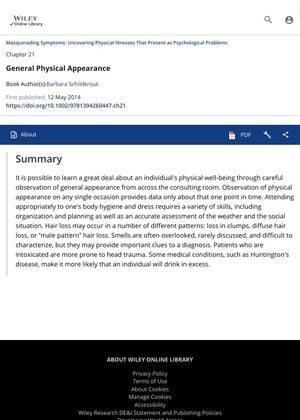TLDR Observing someone's physical appearance can give hints about their health, hygiene, and potential medical conditions.
The document from May 12, 2014, discussed the importance of observing an individual's physical appearance for clues about their health. It emphasized that a single observation only provides data for that specific point in time. The document also highlighted the importance of body hygiene and dress, which require skills such as organization, planning, and an accurate assessment of the weather and social situation. It mentioned different patterns of hair loss, including loss in clumps, diffuse hair loss, and "male pattern" hair loss. The document also noted that certain smells can provide important clues to a diagnosis. It concluded by stating that patients who are intoxicated are more prone to head trauma and that certain medical conditions, like Huntington's disease, increase the likelihood of excessive drinking.
 203 citations
,
December 2004 in “Journal of The American Academy of Dermatology”
203 citations
,
December 2004 in “Journal of The American Academy of Dermatology” Early diagnosis and treatment, using finasteride, minoxidil, or hair transplantation, improves hair loss outcomes.
 14 citations
,
April 2014 in “Medical Clinics of North America”
14 citations
,
April 2014 in “Medical Clinics of North America” The document concludes that quick referral and appropriate treatments are crucial for managing common skin conditions and preventing permanent damage.
 2 citations
,
January 1980 in “Acupuncture & electro-therapeutics research”
2 citations
,
January 1980 in “Acupuncture & electro-therapeutics research” Hair loss might be due to nerve issues, treatable with electric stimulation or acupuncture.
 101 citations
,
January 2016 in “Journal of Cutaneous and Aesthetic Surgery”
101 citations
,
January 2016 in “Journal of Cutaneous and Aesthetic Surgery” Different types of hair loss need specific treatments, and while many classification systems exist, each has its flaws; more research is needed to refine these systems and treatments.
 11 citations
,
November 2015 in “Skin Research and Technology”
11 citations
,
November 2015 in “Skin Research and Technology” Women's hair grows faster and thicker than men's, but hair growth slows for both genders with pattern hair loss.
 26 citations
,
December 2015 in “Journal of The European Academy of Dermatology and Venereology”
26 citations
,
December 2015 in “Journal of The European Academy of Dermatology and Venereology” New method measures female hair loss: Female Pattern Hair Loss Severity Index (FPHL-SI).







